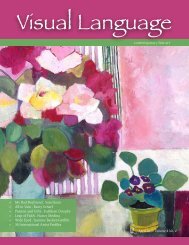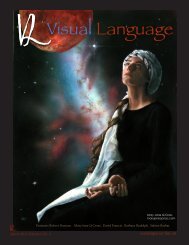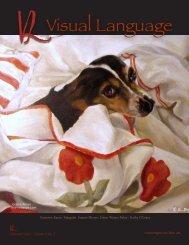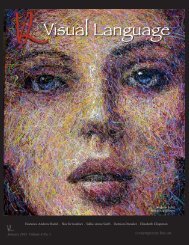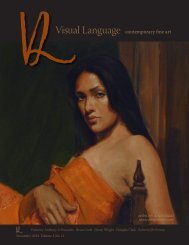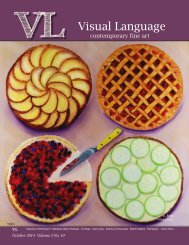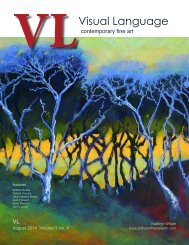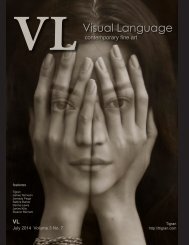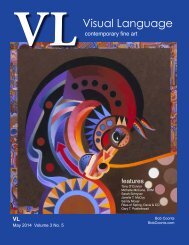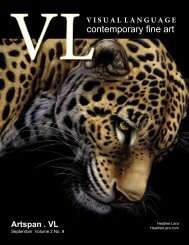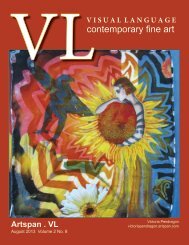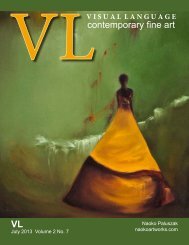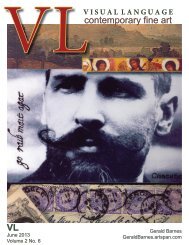Visual Language Magazine Contemporary Fine Art Vol 2 no 10 October 2013
Visual Language Magazine is a contemporary fine art magazine filled with dynamic international fine art, brilliant colors and stimulating composition. This month features the Miller Gallery Fall Show in Cincinnati, and studio visits with Nocona Burgess, Artspan artist Joe Belt, Sarah Beth Banning, Dave Sime, Connie Morse, and Texas artist Kristine Byars. Enjoy an up close and person interview with Texas Artspan artist Sharon Hodges and the gallery show of Texas Artspan artist Melissa Doron. The issue would not be complete without the fascinating photography of Artspan Photographer Rudolph De Ram. On the Cover is the artwork of Artspan Artist Joe Belt. Visual Language is the common connection around the world for art expressed through every media and process. The artists connect through their creativity to the viewers by both their process as well as their final piece. No interpreters are necessary because Visual Language Magazine crosses all boundaries.
Visual Language Magazine is a contemporary fine art magazine filled with dynamic international fine art, brilliant colors and stimulating composition. This month features the Miller Gallery Fall Show in Cincinnati, and studio visits with Nocona Burgess, Artspan artist Joe Belt, Sarah Beth Banning, Dave Sime, Connie Morse, and Texas artist Kristine Byars. Enjoy an up close and person interview with Texas Artspan artist Sharon Hodges and the gallery show of Texas Artspan artist Melissa Doron. The issue would not be complete without the fascinating photography of Artspan Photographer Rudolph De Ram. On the Cover is the artwork of Artspan Artist Joe Belt. Visual Language is the common connection around the world for art expressed through every media and process. The artists connect through their creativity to the viewers by both their process as well as their final piece. No interpreters are necessary because Visual Language Magazine crosses all boundaries.
Create successful ePaper yourself
Turn your PDF publications into a flip-book with our unique Google optimized e-Paper software.
What is the art market like in Australia and in Sydney, in particular<br />
Well, in many ways it’s probably much like anywhere else. It’s got a top end of galleries which are very<br />
much part of the establishment and mainly deal in work by well-k<strong>no</strong>wn artists such as Blackman, Olsen,<br />
and Nolan. It’s where the big money is and there are both those who are genuinely serious collectors using<br />
them and also a fair number of people with their new money chasing a secure and impressive purchase.<br />
They are establishment galleries and part of the Sydney social and artistic landscape. Not quite London’s<br />
Bond Street, but with pretensions in that direction. They tend to deal with artists only when they have<br />
become recognized. Then there are other galleries focusing more on emerging artists, but most often with<br />
a need for these artists to sell fairly easily. They are often smaller galleries in more ‘Generation X and Y’<br />
areas. There is also a representation of galleries specializing in aboriginal work. Not many galleries in Sydney<br />
support experimental art. Installations have <strong>no</strong>t yet made that much of an impact. The <strong>no</strong>n-commercial<br />
galleries (the <strong>Art</strong> Gallery of NSW and the Museum of <strong>Contemporary</strong> <strong>Art</strong>) are pretty good in their own ways,<br />
but the AGNSW has to combine an institutional role with the introduction of a bit of the new. It also suffers<br />
from a degree of schizophrenia over the relationship between its collections of European and Australian art.<br />
Who buys art<br />
There are a number of different markets each with their own characteristics. There is the high-end/establishment/investment/corporate<br />
market which, in truth, plays pretty safe. There are some high-end buyers<br />
who also support emerging artists and a few of these have set up scholarships, trusts, prizes, etc. Then<br />
there are the ‘artistically aware’, drawn from all levels of society, who keep well up with what’s happening in<br />
the world of Australian art, and browse galleries as a pursuit. Then, there are the inexperienced buyers who<br />
are many in number and seem to come into the market at the age of 35+ and then make their first tentative<br />
steps in buying art. They need reassurance on the work and value, and some k<strong>no</strong>wledge of the artist when<br />
buying. It is probably the latter two groups who account for the greater number of sales and gallery visits. In<br />
fact, more Australians visit an art gallery or exhibition per year than attend sporting events!<br />
Is there a clear distinction between what is viewed as commercial art and fine art<br />
There is a distinction made between artists for whom the creation of work is an end in itself and those who<br />
paint with the dollar signs in the their minds. There has been a blurring here; the best example being Ken<br />
Done who was rampantly commercial but recognized by the press and promoted as the ‘new pinnacle of<br />
Australian art’.<br />
How do artists surface in Australia<br />
Many Australian artists are pretty much household names for those with any interest in art. These names<br />
are both drawn from history and from the world of today. Once there was a massive ‘cultural cringe’ in Australia<br />
where anything Australian was automatically regarded as inferior or second rate compared to work<br />
from Europe and America. This still persists in degree but has largely been overtaken as Australia comes to<br />
feel more a real part the world. However, any Australian doing well overseas is still seen as a hero. <strong>Art</strong>ists<br />
are <strong>no</strong>t seen as fringe dwellers in society but a part of what Australia is becoming today, and seen as part<br />
of the broad cultural community that extends to all artistic activities, from opera to rock bands. The Broadsheet<br />
newspapers and magazines give pretty good coverage to artists and exhibitions. There is a growing<br />
appreciation of what artists bring to life and society.<br />
What is the nature of this appreciation<br />
There are many ways of approaching this question. On a banal level, ‘it looks nice in the home’ or ‘impresses<br />
people in the office’. But the value of art in Australia is much more than this. Australia is a country that is<br />
still, after more than 200 years, seeking to define itself and its place in the world. White Australia (a Government<br />
policy until the 1960s!) is long gone as a strand that sought to give Australia some form of national<br />
identity. Australia is <strong>no</strong>w a true multicultural melting pot. Aboriginal Australia is <strong>no</strong>w increasingly being<br />
valued. The nature of employment in Australia has changed and its blue-collar origins are diffusing. The<br />
landscape is ever changing but still blighted by the ‘build it cheap and big’ housing of the post war era and<br />
the ensuing suburban lifestyle and endless suburbs. Then there is a gap between the Australia that tourists<br />
see and the Australia that many Australians see and can see quite differently. It’s still a young country and<br />
is still searching for that elusive identity that will bind all of this diversity together. A recurrent theme in Australian<br />
art is the search for this identity, and much Australian art confronts this by exploring the ordinary and<br />
the day-to-day in a way that brings it to life. There is often a desire to make the painted image more real<br />
than what is being painted, or to deconstruct the familiar into the challenging, and confronting unfamiliar.<br />
http://www.HallGroat.com<br />
<strong>Visual</strong><strong>Language</strong><strong>Magazine</strong>.com - VL <strong>Magazine</strong> | 45



